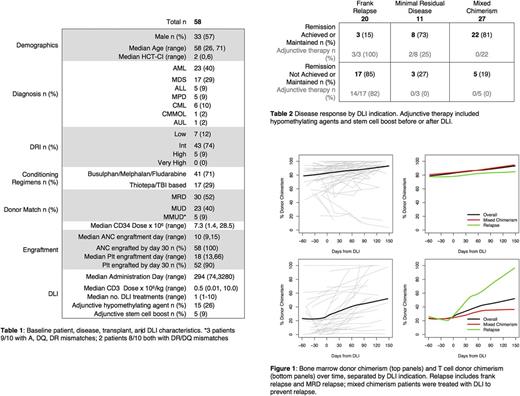Abstract
Introduction Donor lymphocyte infusion (DLI) has been used to prevent or treat relapse after allogeneic hematopoietic stem cell transplantation (alloHCT) since the 1990s. Retrospective series have reported variable efficacy (CML up to 60%, ALL 0% in some series) with rates of DLI-associated graft-versus host disease (GVHD) of 40-60%. DLI's ability to potentiate graft versus leukemia effects and GVHD are thought to be primarily T Cell mediated, and T cell chimerism, repertoire, and exhaustion may have important influence on outcomes.
The use of ex-vivo T cell depleted CD34 selected alloHCT has been shown to provide similar survival to unmodified grafts but with lower acute and chronic GVHD, and is now being studied in a randomized trial exploring calcineurin inhibitor free GVHD prevention regimens (BMT CTN 1301). There is however limited data on DLI in this context. Here we describe safety and efficacy outcomes of DLI in recipients of CD34 selected alloHCT.
Methods This retrospective study included all CD34 selected alloHCT recipients at our center who received DLI from January 2005 to January 2016 for treatment or prevention of relapse. We excluded patients with multiple myeloma as these results have been reported elsewhere. Primary outcomes were maintenance or achievement of disease remission, and change in whole bone marrow and peripheral T Cell chimerism over time. A loess smoothed curve was used to visually display changes in chimerism over time and to provide time point chimerism estimates.
Results 58 patients received DLI for frank relapse (n=20), minimal residual disease (MRD, n=11), or for relapse prevention in the context of mixed marrow or peripheral blood chimerism (n=27). AML (40%) and MDS (29%) were the most common diagnoses, and most patients (74%) had intermediate disease risk index (Table 1). All patients received peripheral blood stem cell grafts and myeloablative conditioning. Median DLI dose was 0.5 x 106 CD3 cells/kg (0.01-10.0) with 86% of patients receiving doses between 0.1 and 1.0 x 106 CD3 cells/kg. DLI was most often given once (67%), with some patients having 2 (21%) or > 2 treatments (12%). Of the 20 patients who received DLI for frank relapse, 3 (15%) achieved remission, and of the 11 patients who received DLI for minimal residual disease, 8 (73%) achieved remission. Of the 27 patients with mixed chimerism treated with preventive DLI, remission was maintained in 22 (81%). Achieving or maintaining remission was not independently associated with underlying diagnosis, use of adjunctive hypomethylating agents or stem cell boost, or DLI dose or frequency in this cohort. DLI resulted in an average whole bone marrow donor chimerism increase after DLI, regardless of DLI indication (9% at 90 days; Fig 1). T Cell donor chimerism also increased after DLI, with a more pronounced increase in patients treated for relapse (50%) than those treated for relapse prevention (12%; Fig 1). Prior to DLI, rates of grade II-IV and III-IV acute GVHD were 10 and 3% respectively, and no patients had moderate or severe chronic GVHD. All GVHD had resolved prior to DLI administration. After DLI we observed 2 episodes (3%) of late acute grade II-IV GVHD (both grade III skin), and 4 episodes (7%) of moderate-severe chronic GVHD with median onset of 99 and 80 days post DLI, respectively (range 44-401).
Conclusions DLI given after CD34+ selected alloHCT was associated with GVHD rates that were substantially lower than reported in other DLI contexts. Disease response to DLI was higher in MRD positive patients than for those with frank relapse (15 vs 73%), suggesting that regular MRD assessment and prompt DLI administration may be an effective relapse prevention strategy in MRD positive patients. The low relapse rate observed in patients with mixed chimerism receiving preventive DLI (19%) was not substantially different than historical relapse rates observed in CD34+ selected patients at our institution, so does not yet provide a convincing signal to explore DLI for relapse prevention in the absence of MRD. In summary, DLI given after T Cell depleted alloHCT was associated with low rates of GVHD and may be an effective strategy to prevent frank relapse in MRD positive patients after alloHCT. Acknowledging the inherent limitations of our small sample size, our observations suggest broader exploration of this safe and potentially effective strategy is warranted.
No relevant conflicts of interest to declare.
Author notes
Asterisk with author names denotes non-ASH members.


